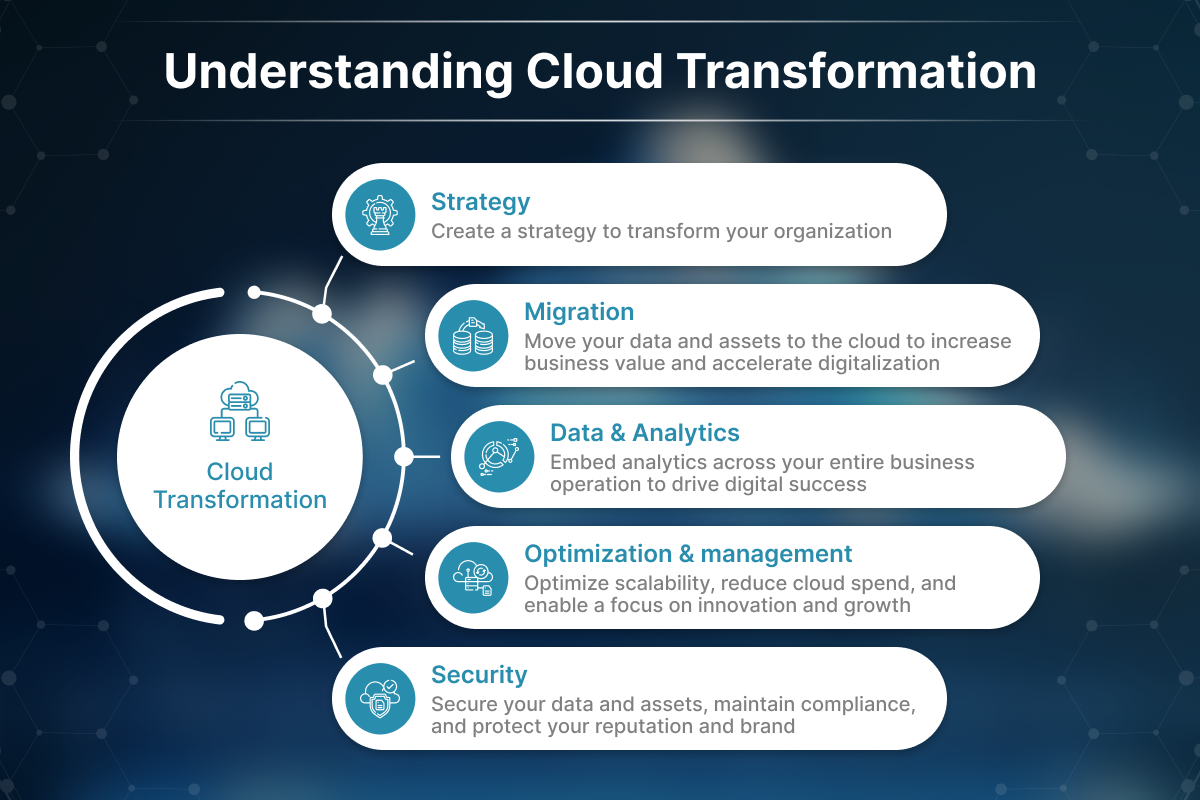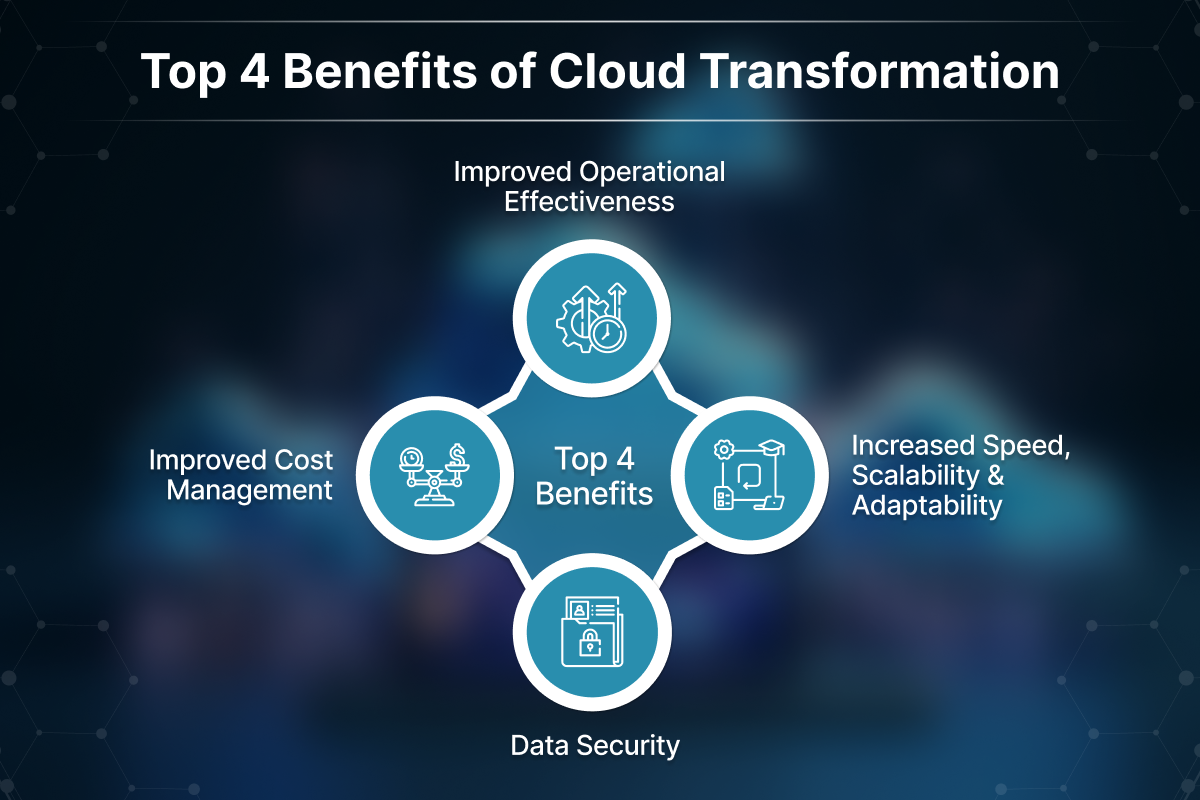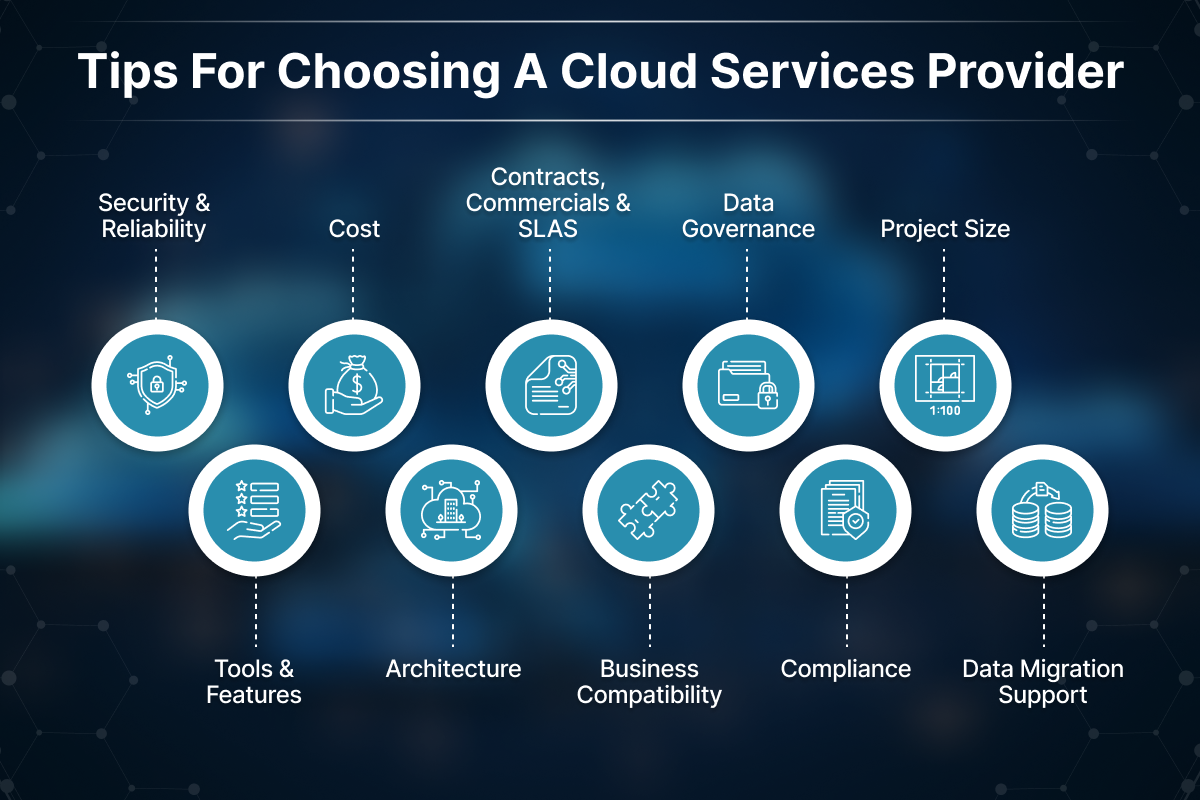The Benefits of Cloud Transformation for Modern Enterprises
-min.png)
Remember that corner store down the street, the one that always seemed to have a line out the door? Now imagine them experiencing explosive growth, tripling their inventory and customer base overnight. Their quaint on-premise cash register wouldn't stand a chance, right?
This is the reality facing many businesses today. The traditional model of on-premise IT infrastructure, like that trusty cash register, simply can't keep pace with the demands of a rapidly evolving market. Data storage needs are ballooning, application performance is sluggish, and scaling resources feels like an uphill battle. Take, for instance, a thriving eCommerce experiencing explosive growth crawling under the weight of peak season traffic. Adding new servers takes weeks, hindering their ability to capitalize on hot trends.
The most plausible solution to this bottleneck is Cloud Computing. Cloud computing offers on-demand access to a virtual pool of computing resources – storage, servers, databases, and networking – hosted by a cloud service provider (CSP). This eliminates the need for expensive physical infrastructure, allowing businesses to scale resources up or down in minutes to meet fluctuating demands.
The benefits of cloud computing are undeniable, and its adoption is surging. As per O’Reiley’s latest Cloud Adoption report, more than 90% of enterprises have already adopted cloud solutions, with an even greater number planning to migrate in the coming years This trend suggests cloud adoption is no longer a "maybe" for modern enterprises, it's a strategic imperative.
The Need for Cloud Transformation
Modern enterprises relying on on-premise IT infrastructure face a multitude of challenges that hinder their ability to adapt and innovate.
- Scalability Limitations: Traditional infrastructure is built with a fixed capacity, often struggling to adapt to fluctuating business demands. Scaling up requires physically adding hardware, a time-consuming and expensive process. Unexpected spikes in traffic can lead to system outages and lost productivity.
- High Maintenance Costs: On-premise infrastructure demands constant upkeep. IT teams dedicate a significant portion of their resources to hardware maintenance, software updates, and patching vulnerabilities. These ongoing costs can strain budgets and limit resources for strategic IT initiatives.
- Security Vulnerabilities: Maintaining robust security measures in-house requires specialized skills and ongoing investment. Legacy systems are often more susceptible to cyberattacks, putting sensitive data at risk. Patching vulnerabilities can be a complex and time-consuming process.
- Difficulty in Keeping Up with Innovation: Technological advancements happen at a rapid pace. On-premise infrastructure often struggles to keep up with the latest hardware and software iterations. This can hinder an enterprise's ability to leverage emerging technologies and maintain a competitive edge.
Understanding Cloud Transformation
While simply migrating data to the cloud offers some benefits, true cloud transformation goes far beyond. It's a strategic business shift that involves rethinking how IT operates and harnesses cloud resources to achieve optimal efficiency and agility. Cloud transformation includes migrating applications, data, and IT processes to the cloud, along with re-architecting them to maximize the benefits of cloud-native features like scalability, elasticity, and automated services. There are several cloud deployment models to consider, each offering a different level of control and security:
There are several cloud deployment models to consider, each offering a different level of control and security:
Dominating the cloud computing space are leading Cloud Service Providers (CSPs) like Google Cloud Platform (GCP), Microsoft Azure, and Amazon Web Services (AWS). Each offers a comprehensive suite of cloud services and boasts unique strengths.
- Google Cloud Platform (GCP): Known for its cutting-edge AI and machine learning capabilities, containerization technologies (Kubernetes), and focus on open-source solutions.
- Microsoft Azure: Strong integration with existing Microsoft products and on-premise infrastructure, ideal for organizations already invested in the Microsoft ecosystem.
- Amazon Web Services (AWS): The largest and most mature cloud platform, offering the broadest range of services and global reach.
Beyond core cloud infrastructure, leading CSPs also offer Cloud & DevOps Services. These services optimize the development and deployment processes by providing tools for infrastructure automation, continuous integration/continuous delivery (CI/CD), and container orchestration. Cloud & DevOps Services help developers innovate faster and deliver applications more efficiently.
Benefits of Cloud Transformation for Modern Enterprises
Cloud transformation offers businesses a multitude of advantages, fostering agility, cost-efficiency, enhanced collaboration, and robust security.
Enhanced Agility and Scalability
One of the most significant advantages of cloud computing is its inherent scalability. Unlike on-premise infrastructure, cloud resources like storage and computing power can be scaled up or down on demand. This agility allows businesses to adapt quickly to changing market conditions and seize new opportunities. Suppose your company is developing a mobile app that experiences a sudden surge in downloads. With cloud infrastructure, you can instantly scale up resources to handle the increased traffic, ensuring a smooth user experience without any downtime. This eliminates the need for expensive upfront investments in hardware that may not be fully utilized later.
Furthermore, cloud computing facilitates the adoption of serverless architecture. This eliminates the need for managing servers altogether, allowing developers to focus solely on writing code. Serverless applications automatically scale based on demand, offering unparalleled scalability and cost-efficiency. Leading Cloud Service Providers (CSPs) like Google Cloud Computing services, Microsoft Azure, and Amazon Cloud Computing services all offer robust Infrastructure as a Service (IaaS) solutions that provide this on-demand scalability.
For instance, our company specializes in building custom cloud solutions. We can help a retail client migrate their e-commerce platform to the cloud. This could not only improve website performance but also allow them to easily scale resources during peak seasons like Black Friday and Cyber Monday. They could then handle sudden spikes in traffic without compromising speed or security.
Improved Cost Efficiency
Cloud computing operates on a pay-as-you-go model, eliminating the need for hefty upfront capital expenditure on hardware and software licenses. You only pay for the resources you use, significantly reducing IT costs. Additionally, cloud providers handle all infrastructure maintenance and patching, freeing up your IT staff to focus on strategic initiatives.
Consider the Total Cost of Ownership (TCO) of on-premise infrastructure. This includes not just the initial hardware and software costs, but also the ongoing expenses for maintenance, staff, electricity, and potential upgrades. Cloud computing can significantly lower your TCO by eliminating these expenses. Furthermore, many CSPs offer cloud cost optimization services that help you identify and eliminate resource waste, further maximizing your return on investment.
Increased Collaboration and Productivity
Cloud-based applications and data storage aid geographically dispersed teams to collaborate seamlessly. Team members can access and edit documents in real time, promoting communication and accelerating project completion. Features like file sharing, document version control, and instant messaging tools eliminate the need for email attachments and outdated spreadsheets, optimizing workflows and boosting productivity.
Cloud & DevOps Services play a crucial role in this enhanced collaboration. These services provide tools for infrastructure automation, continuous integration/continuous delivery (CI/CD), and container orchestration. This allows development teams to work more efficiently and deploy applications faster, accelerating your time-to-market.
Enhanced Security and Business Continuity
A common misconception is that cloud security is less robust than on-premise solutions. Leading cloud providers like GCP, Microsoft Azure Cloud services, and AWS invest heavily in state-of-the-art security infrastructure, including encryption, access controls, and intrusion detection systems. These measures often exceed what most enterprises can manage on-premise. Additionally, robust disaster recovery solutions ensure business continuity in the face of unexpected events.
Furthermore, these providers achieve compliance certifications like SOC 2 and HIPAA, offering peace of mind regarding data privacy and security. Cloud providers also offer features that simplify adhering to data privacy regulations like GDPR and CCPA. This optimizes compliance efforts and mitigates risk.
Choosing the Right Cloud Partner for Your Transformation
With a myriad of cloud service providers (CSPs) and deployment models (Public, Private, Hybrid) available, selecting the right partner is crucial for a successful cloud transformation. Here are some key factors to consider.
- Deployment Model: Public cloud offers scalability and cost-efficiency, but may have limitations on security and control. Private cloud provides the highest level of security and control but comes with higher costs and management complexity. Hybrid cloud offers a blend of both, allowing you to personalize your cloud usage based on specific needs.
- Security: Assess the provider's security track record, compliance certifications, and disaster recovery solutions. Ensure they align with your organization's security posture and data privacy regulations.
- Scalability: Consider your current and future resource needs. Choose a provider with a robust infrastructure that can scale seamlessly to accommodate your growth.
- Compliance: If your industry has specific compliance requirements, ensure the provider offers the necessary certifications (e.g., HIPAA for healthcare) and features to simplify compliance adherence.
- Existing IT Infrastructure: Evaluate how your existing infrastructure integrates with the provider's cloud platform. Some providers offer smoother integration for specific on-premise environments.

WebClues Infotech brings extensive expertise to the table, having successfully guided numerous enterprises through cloud transformation. We possess in-depth knowledge of leading cloud platforms like Google Cloud Platform (GCP), Microsoft Azure, and Amazon Web Services (AWS), allowing us to recommend the best fit based on your unique needs and existing infrastructure.
Our cloud consulting services involve comprehensive assessments, migration planning, and ongoing support throughout your cloud migration. We tap into our expertise to ensure a smooth transition, maximizing the benefits of cloud adoption for your business.
Collaborate with WebClues for Efficient Cloud Transformation
At WebClues, we understand that cloud transformation is a strategic decision with significant implications. We are committed to partnering with you every step of the way, ensuring a successful and secure transition to the cloud.
We invite you to take the first step towards a more agile, secure, and cost-effective future. Contact us today for a free consultation and hire cloud developers. We'll assess your specific needs and recommend the optimal cloud solution customized for your success.
Build Your Agile Team
Hire Skilled Developer From Us
Boost your enterprise operations with Webclues-assisted cloud transformation
Cloud transformation is a strategic imperative for enterprises. At Webclues, we have the resources to facilitate a foolproof cloud transformation for your business.
Get a Quote!Our Recent Blogs
Sharing knowledge helps us grow, stay motivated and stay on-track with frontier technological and design concepts. Developers and business innovators, customers and employees - our events are all about you.
Contact Information
Let’s Transform Your Idea into Reality - Get in Touch
India
Ahmedabad
1007-1010, Signature-1,
S.G.Highway, Makarba,
Ahmedabad, Gujarat - 380051
Rajkot
1308 - The Spire, 150 Feet Ring Rd,
Manharpura 1, Madhapar, Rajkot, Gujarat - 360007
UAE
Dubai
Dubai Silicon Oasis, DDP,
Building A1, Dubai, UAE
USA
Delaware
8 The Green, Dover DE, 19901, USA
New Jersey
513 Baldwin Ave, Jersey City,
NJ 07306, USA
California
4701 Patrick Henry Dr. Building
26 Santa Clara, California 95054
Australia
Queensland
120 Highgate Street, Coopers Plains, Brisbane, Queensland 4108
UK
London
85 Great Portland Street, First
Floor, London, W1W 7LT
Canada
Burlington
5096 South Service Rd,
ON Burlington, L7l 4X4





